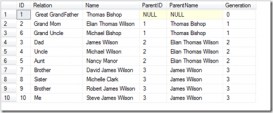一、排名开窗函数概述
SQL Server的排名函数是对查询的结果进行排名和分组,TSQL共有4个排名函数,分别是:ROW_NUMBER、RANK、DENSE_RANK和NTILE。
他们和OVER()函数搭配使用,按照特定的顺序排名。
排名开窗函数可以单独使用ORDER BY 语句,也可以和PARTITION BY同时使用。
- PARTITION BY用于将结果集进行分组,开窗函数应用于每一组。
- ODER BY 指定排名开窗函数的顺序。在排名开窗函数中必须使用ORDER BY语句。
1、ROW_NUMBER:行号
为每一组的行按顺序生成一个唯一的序号。
序列从1开始,按照顺序依次 +1 递增。分组内序列的最大值就是该分组内的行的数目。
ROW_NUMBER ( ) OVER ( [ PARTITION_BY_clause ] order_by_clause )
2、RANK:排名
也为每一组的行生成一个序号,但如果按照ORDER BY的排序,如果有相同的值会生成相同的序号,并且接下来的序号是不连续的。
例如,班级中,A,B分数都是100分,C的分数是90分,那么A和B的排名是1,C的排名是3。
3、DENSE_RANK:密集排名
和RANK(排名)类似,不同的是如果有相同的序号,那么接下来的序号不会间断。
例如,班级中,A,B分数都是100分,C的分数是90分,那么A和B的排名是1,C的排名是2。
4、NTILE :分组排名
按照指定的数目将数据进行分组,并为每一组生成一个序号。
特别地,NTILE(4) 把一个分组分成4份,叫做Quartile。例如,以下脚本显示各个排名函数的执行结果:
select Department
,LastName
,Rate
,row_number() over(order by Rate) as [row number]
,rank() over(order by rate) as rate_rank
,dense_rank() over(order by rate) as rate_dense_rank
,ntile(4) over(order by rate) as quartile_by_rate
from #data
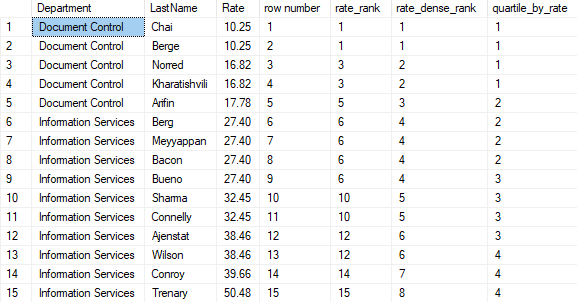
二、分析函数
分析函数基于分组,计算分组内数据的聚合值,经常会和窗口函数OVER()一起使用,使用分析函数可以很方便地计算同比和环比,获得中位数,获得分组的最大值和最小值。
分析函数和聚合函数不同,不需要GROUP BY子句,对SELECT子句的结果集,通过OVER()子句分组。
注意:distinct子句的执行顺序是在分析函数之后。
使用以下脚本插入示例数据:
;with cte_data as ( select "Document Control" as Department,"Arifin" as LastName,17.78 as Rate union all select "Document Control","Norred",16.82 union all select "Document Control","Kharatishvili",16.82 union all select "Document Control","Chai",10.25 union all select "Document Control","Berge",10.25 union all select "Information Services","Trenary",50.48 union all select "Information Services","Conroy",39.66 union all select "Information Services","Ajenstat",38.46 union all select "Information Services","Wilson",38.46 union all select "Information Services","Sharma",32.45 union all select "Information Services","Connelly",32.45 union all select "Information Services","Berg",27.40 union all select "Information Services","Meyyappan",27.40 union all select "Information Services","Bacon",27.40 union all select "Information Services","Bueno ",27.40 ) select Department,LastName,Rate into #data from cte_data go
SQL Server中共有4类分析函数。
1、LAG和LEAD
在一次查询中,对数据表进行排序,把已排序的数据从上向下看作是一个序列,对当前行而言,在序列上方的为后,在序列下方的为前。
在同一分组内,对于当前行:
- Lag()函数:用于获取从当前行开始向后(或向上)计数的第N行。
- Lead()函数:用于获取从当前行开始向前(或向下)计数的第N行。
LAG (scalar_expression [,offset] [,default]) OVER ( [ partition_by_clause ] order_by_clause ) LEAD ( scalar_expression [ ,offset ] , [ default ] ) OVER ( [ partition_by_clause ] order_by_clause )
参数注释:
- sclar_expression:标量表达式
- offset:默认值是1,必须是正整数,对于LAG()函数表示从当前行(current row)回退的行数,对于LEAD()表示从当前行向前进的行数。
- default :当offset超出分区范围时要返回的值。 如果未指定默认值,则返回NULL。 default可以是列,子查询或其他表达式,但必须跟sclar_expression类型兼容。
结果日期,这两个函数特别适合用于计算同比和环比。
select DepartMent ,LastName,Rate
,lag(Rate,1,0) over(partition by Department order by LastName) as LastRate
,lead(Rate,1,0) over(partition by Department order by LastName) as NextRate
from #data order by Department ,LastName
按照DepartMent进行分组,对Document Control这一小组进行分析:
- 第一行,对于LastRate字段,向后不存在数据行,返回参数Default的值,字段NextRate的值是第二行的Rate字段的值。
- 第二行,LastRate是第一行的Rate字段的值,NextRate是第三行的Rate字段的值。对于中间行,依次类推。
- 最后一行,LastRate是倒数第二行的Rate字段的值,对于NextRate字段,由于最后一行向前不存在数据行,返回参数Default的值。
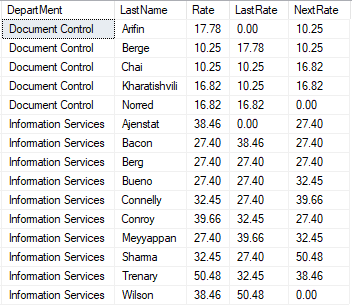
以下程序代码用来示范如何透过 LAG 函数来计算每一列与前一列的 c2 字段相差几天:
declare @t table
(
c1 int identity
,c2 date
)
insert into @t (c2)
select "20120101"
union all
select "20120201"
union all
select "20120110"
union all
select "20120221"
union all
select "20120121"
union all
select "20120203"
select c1,c2
,LAG(c2) OVER (ORDER BY c2) as previous_c2
,DateDiff(day,LAG(c2) OVER (ORDER BY c2),c2) as diff
from @t
order by c2
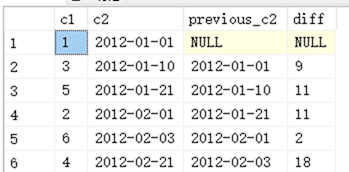
2、FIRST_VALUE和LAST_VALUE
SQL SERVER 2012引入的函数。
获取分组内排在最末尾的行和排在第一位的行:
LAST_VALUE ( [scalar_expression ) OVER ( [ partition_by_clause ] order_by_clause rows_range_clause ) FIRST_VALUE ( [scalar_expression ] ) OVER ( [ partition_by_clause ] order_by_clause [ rows_range_clause ] )
例如:
select Department, LastName, Rate,
row_number() over (partition by Department order by LastName) as FIRSTVALUE,
first_value(Rate) over (partition by Department order by LastName rows between unbounded preceding and unbounded following) as FIRSTVALUE,
last_value(Rate) over (partition by Department order by LastName rows between unbounded preceding and unbounded following) as LASTVALUE
from #data
order by Department, LastName;
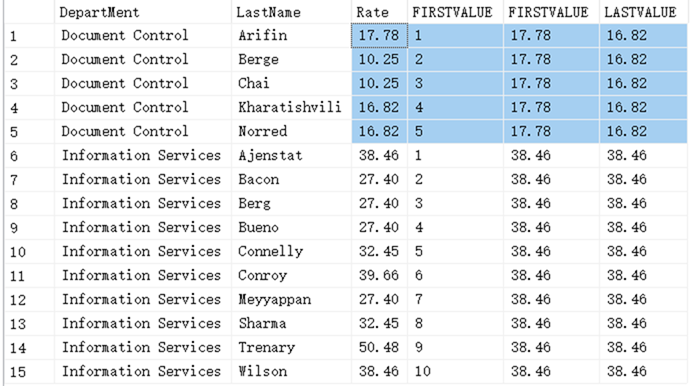
3、CUME_DIST 和PERCENT_RANK:累积分布和排名百分比
- CUME_DIST() :小于等于当前值的行数/分组内总行数
- PERCENT_RANK() :(分组内当前行的RANK值-1)/ (分组内总行数-1),排名值是RANK()函数排序的结果值。
以下代码,用于计算累积分布和排名百分比:
select Department,LastName ,Rate
,cume_dist() over(partition by Department order by Rate) as CumeDist
,percent_rank() over(partition by Department order by Rate) as PtcRank
,rank() over(partition by Department order by Rate asc) as rank_number
,count(0) over(partition by Department) as count_in_group
from #data
order by DepartMent
,Rate desc
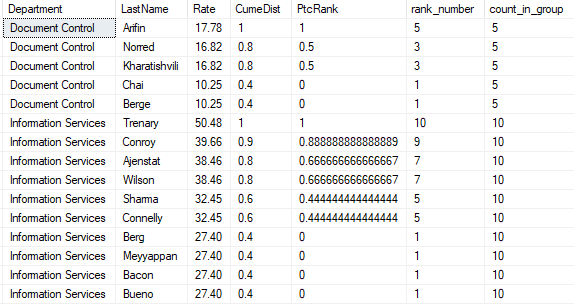
解释:
首先,NULL都会被当作最小值。
1、cume_dist的计算方法:小于等于当前行值的行数/总行数。
比如,第3行值为16.82,有4行的值小于等于16.82,本组总行数5行,因此CUME_DIST为4/5=0.8 。
再比如,第4行值为10.25,行值小于等于10.25的共2行,本组总行数5行,因此CUME_DIST为2/5=0.4 。
2、PERCENT_RANK的计算方法:当前RANK值-1/总行数-1 。
比如,第4行的RANK值为1,本组总行数5行,因此PERCENT_RANK为1-1/5-1= 0。
再比如,第7行的RANK值为9,本组总行数10行,因此PERCENT_RANK为9-1/10-1=0.8888888888888889。
4、PERCENTILE_CONT和PERCENTILE_DISC:百分位的数值
PERCENTILE_CONT和PERCENTILE_DISC都是为了计算百分位的数值,比如计算在某个百分位时某个栏位的数值是多少。
- PERCENTILE_CONT是连续型,CONT代表continuous,连续值,意味它考虑的是区间,所以值是绝对的中间值;
- PERCENTILE_DISC是离散型,DISC代表discrete,离散值。所以它更多考虑向上或者向下取舍,而不会考虑区间。
以下脚本用于获得分位数:
select Department ,LastName ,Rate
,PERCENTILE_CONT(0.5) WITHIN GROUP (ORDER BY Rate) OVER (PARTITION BY Department) AS MedianCont
,PERCENTILE_DISC(0.5) WITHIN GROUP (ORDER BY Rate) OVER (PARTITION BY Department) AS MedianDisc
,row_number() over(partition by Department order by Rate) as rn
from #data order by DepartMent ,Rate asc
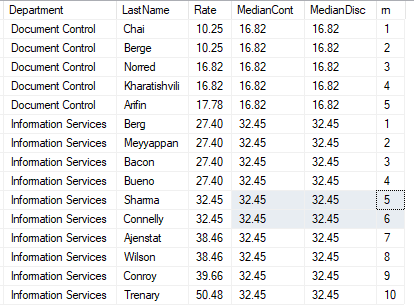
到此这篇关于SQL Server排名函数与分析函数的文章就介绍到这了。希望对大家的学习有所帮助,也希望大家多多支持服务器之家。
原文地址:https://www.cnblogs.com/springsnow/p/9591083.html


